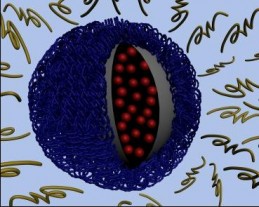Removable ‘cloak’ for nanoparticles helps them target tumors
May 4, 2011
A new type of drug-delivery nanoparticle that could target nearly any type of tumor and carry virtually any type of drug has been developed by chemists at MIT.
The new nanoparticles are cloaked in a polymer layer that protects them from being degraded by the bloodstream and can survive in the bloodstream for up to 24 hours.
This outer layer falls off after entering the slightly more acidic environment near a tumor, revealing another layer that is able to penetrate individual tumor cells.
The tumor acidity is a byproduct of the tumor’s intensified metabolism. Tumor cells grow and divide much more rapidly than normal cells, and that metabolic activity uses up a lot of oxygen, which increases acidity. As the tumor grows, the tissue becomes more and more acidic.
To build their targeted particles, the researchers used a technique called “layer-by-layer assembly.” This means each layer can be tailored to perform a specific function.

The polymer coating (light blue) is shed as the particle approaches a tumor, exposing positive charges. Those charges help the particle be absorbed through the tumor cell membrane. (Credit: Stephen Morton)
When the outer layer (made of polyethylene glycol, or PEG) breaks down in the tumor’s acidic environment, a positively charged middle layer is revealed, allowing the nanoparticle to penetrate the negatively charged cell membrane.
The nanoparticles’ innermost layer can be a polymer that carries a cancer drug, or a quantum dot that could be used for imaging, or virtually anything else that the designer might want to deliver.
These particles are the first that have been successfully tested in living animals by targeting acidity, the researchers said.
Ref: Zhiyong Poon, Dongsook Chang, Xiaoyong Zhao, Paula T. Hammond, Layer-by-Layer Nanoparticles with a pH Sheddable Layer for In Vivo Targeting of Tumor Hypoxia, ACS Nano, 2011; : 110423130803069 DOI: 10.1021/nn200876f
